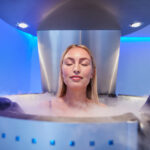by: October 23, 2023
 (NaturalHealth365) While many are familiar with the concept of using extreme heat, known as hyperthermia, to enhance the immune system or as a therapeutic approach for cancer treatment, fewer have ventured into the realm of extreme cold therapy. This lesser-known practice, known as cryotherapy, involves exposing the body to frigid temperatures, potentially producing remarkable healing effects.
(NaturalHealth365) While many are familiar with the concept of using extreme heat, known as hyperthermia, to enhance the immune system or as a therapeutic approach for cancer treatment, fewer have ventured into the realm of extreme cold therapy. This lesser-known practice, known as cryotherapy, involves exposing the body to frigid temperatures, potentially producing remarkable healing effects.
In this exploration, we delve into the fascinating world of cryotherapy and its implications for individuals navigating the challenges of cancer.
Whole body cryotherapy: Is this just a “health fad?”
The use of cold to reduce the swelling of a twisted ankle or to provide pain relief for an aching back has been around for decades. The simplest version of this – a plain, old ice pack (or frozen bag of peas if you don’t have anything else) – is, in fact, a localized version of cryotherapy. Applying a very cold substance directly onto blood vessels will cause them to restrict, lowering inflammation, alleviating pain, and boosting healing.
The practice of Whole Body Cryotherapy (WBC), however, is a fairly new phenomenon, yet new centers (some staffed with medical professionals and some not) continue to pop up everywhere. Even celebrities are getting on the cryo bandwagon, with the likes of Lebron James, Jennifer Aniston, and Jessica Alba claiming it does wonders for their energy level and pain.
With WBC, a person places themselves in a tank or small room and either liquid nitrogen or refrigerated cold air is pumped in around them. Sometimes, the temp can get to minus 150 degrees Fahrenheit! You are only submerged in this subzero environment for 2 to 4 minutes. In most places, cryo participants wear gloves, hard-soled shoes, and a face mask and are encouraged to move around continuously.
How WBC improves immune function by reducing inflammation
Whole-body cryotherapy originated in the 1970s with Japanese rheumatologist Toshima Yamauchi, who developed the procedure for his patients. Since then, studies have shown that WBC can improve circulation in the skin and in the connective tissues, tendons, muscles, and joints. Individuals with rheumatoid arthritis, fibromyalgia, neurological and orthopedic disorders, and some skin and lung diseases tend to benefit the most from whole-body cryotherapy.
Researchers have also discovered that, if done in a professional environment where duration and temperature are carefully monitored, the procedure may boost some functions of the immune system as well. A report published by the University of Milan School of Medicine found an increase in anti-inflammatory cytokines (interleukin- 10) and a decrease in pro-inflammatory cytokines with whole-body cryotherapy use amongst athletes.
Best advice: Choose immune boosters that work best with YOUR body for cancer prevention
I think that whole-body cryotherapy does provide some benefits for the immune system, and it appears to help alleviate the pain that would come with rheumatic conditions such as arthritis.
If you are considering it for cancer prevention or basic immune enhancement, remember that exposing your whole body to subfreezing temperatures will elevate certain stress hormones, such as adrenaline (if only for a few minutes).
If you are young, fairly fit, or already know that you do well with cold therapies in general, then WBC may be a great choice for you. However, if you suffer from conditions such as hypothyroidism, perhaps other more gentle modalities for boosting the immune system, or a milder form of cryotherapy, such as hot-and-cold (or cold-plunge) hydrotherapy, may be a better choice for maintaining optimum health, vitality, and cancer prevention.
Today, there are hundreds of immune-boosting healing modalities out there to choose from. This is great news if you’re on a healing path with breast cancer because the same modality that may not work for your friend may be just what you need.
If cryotherapy is something you wish to explore, make sure that you do so with a registered facility that has medical professionals on staff at all times.
Sources for this article include:
NIH.gov
Forbes.com
Link.springer.com
NIH.gov
Wiley.com
BreastCancerConqueror.com
No hay comentarios:
Publicar un comentario